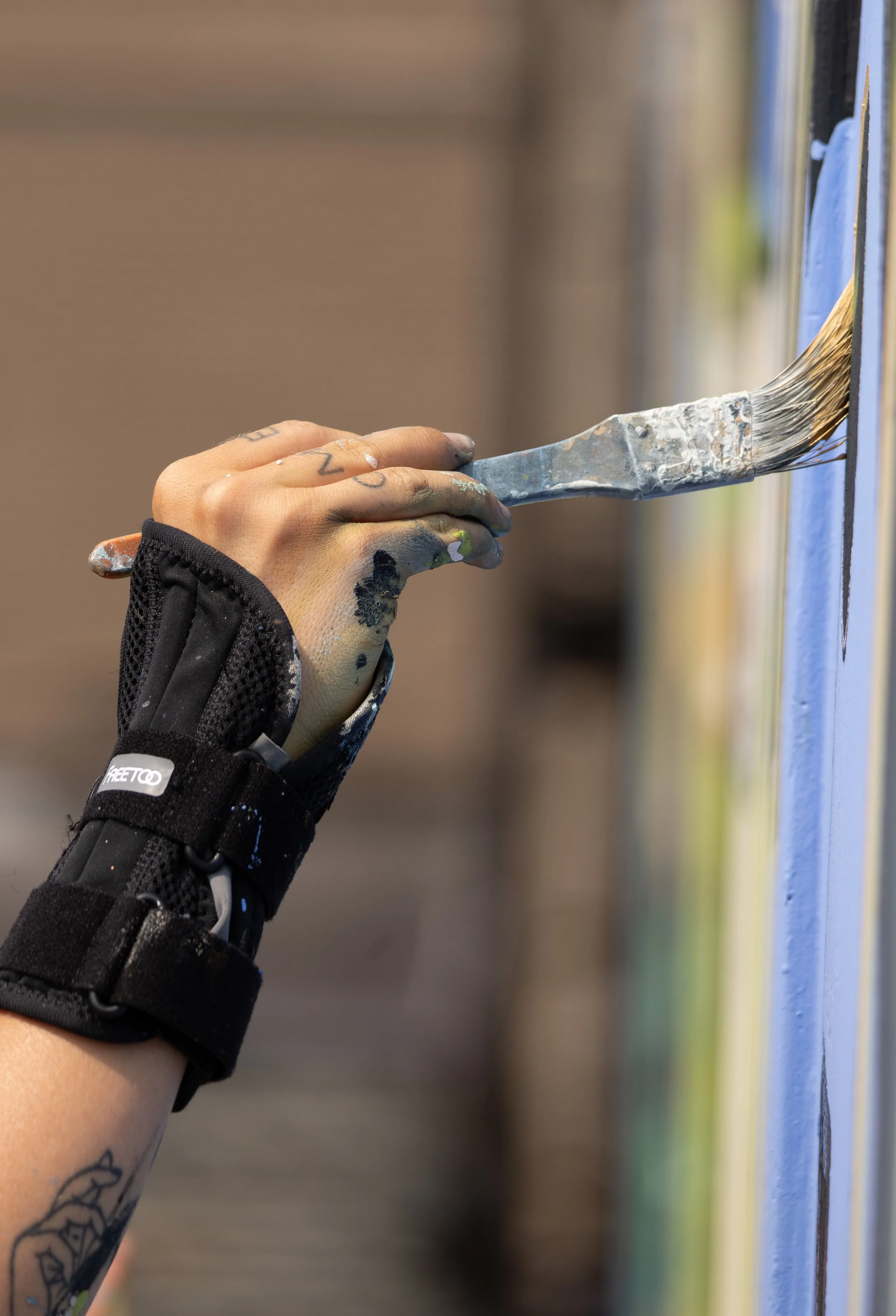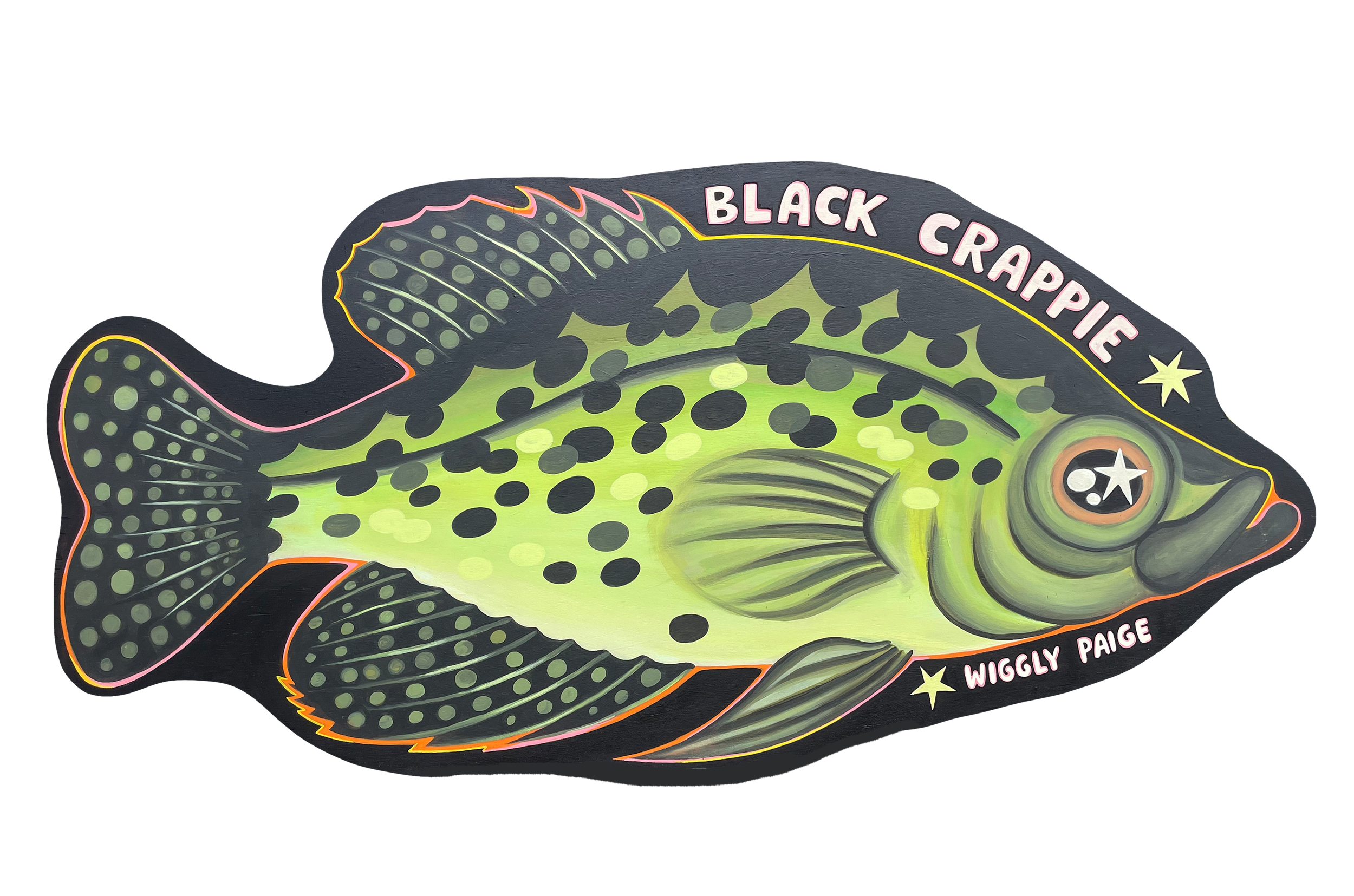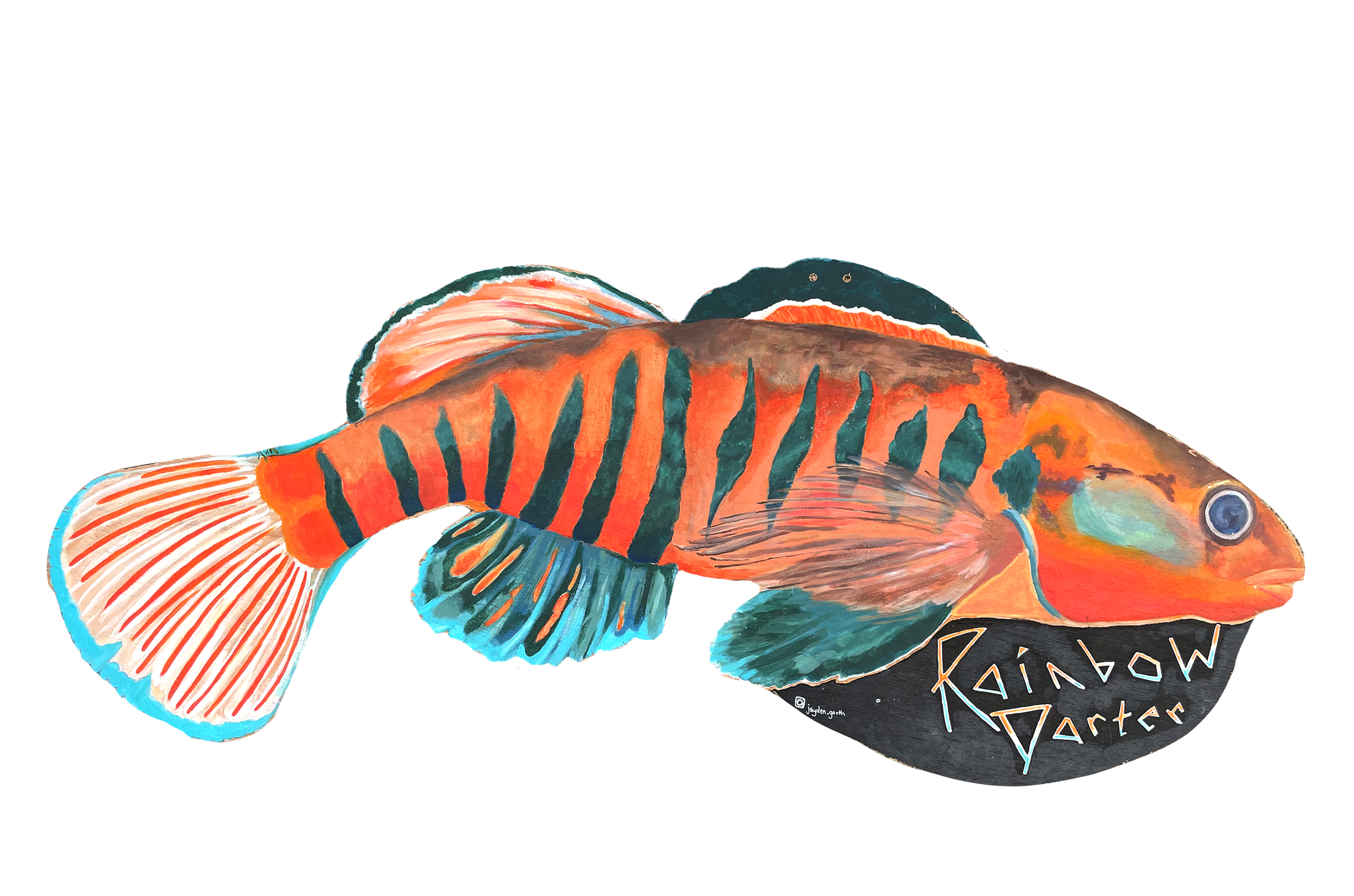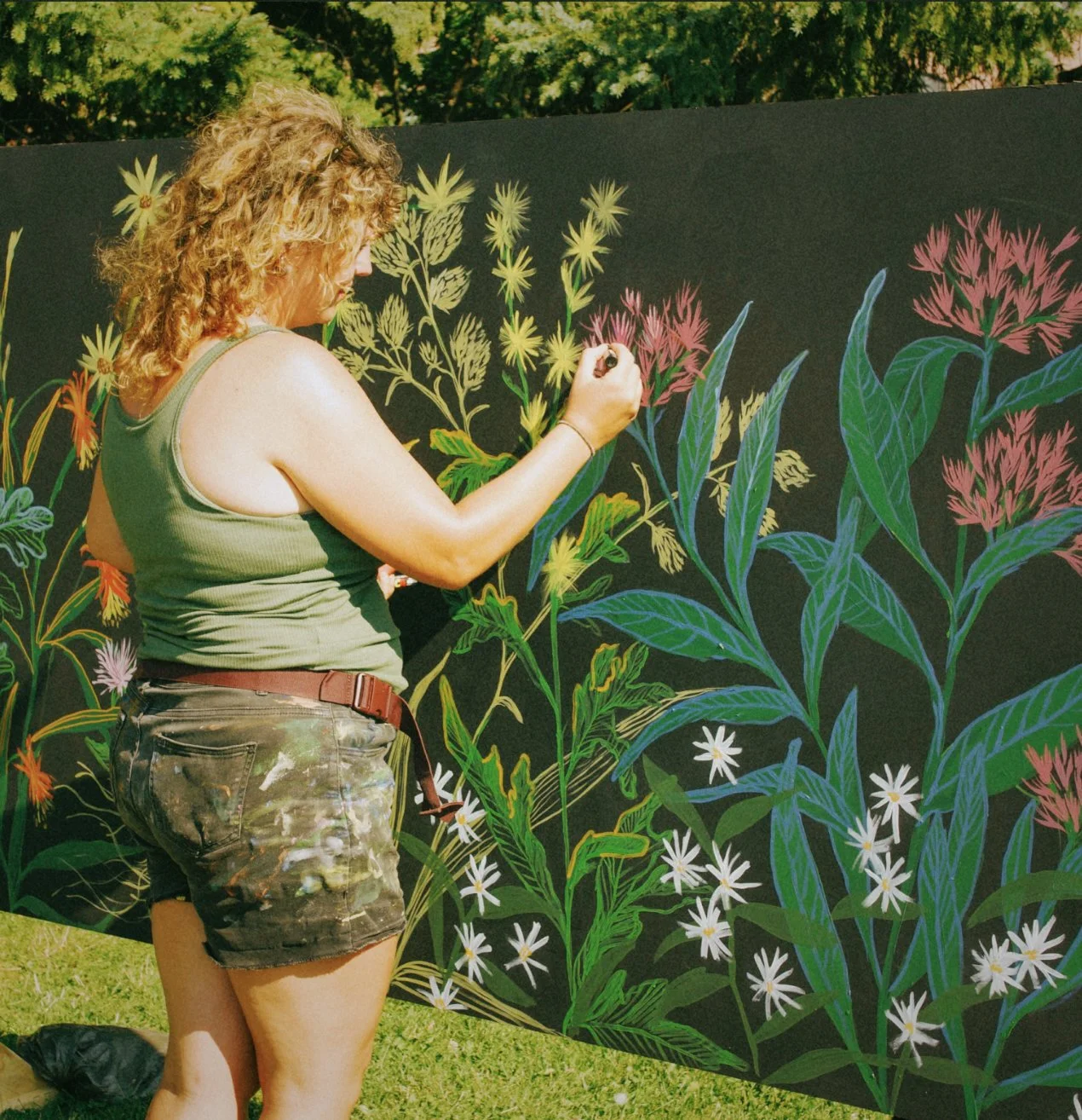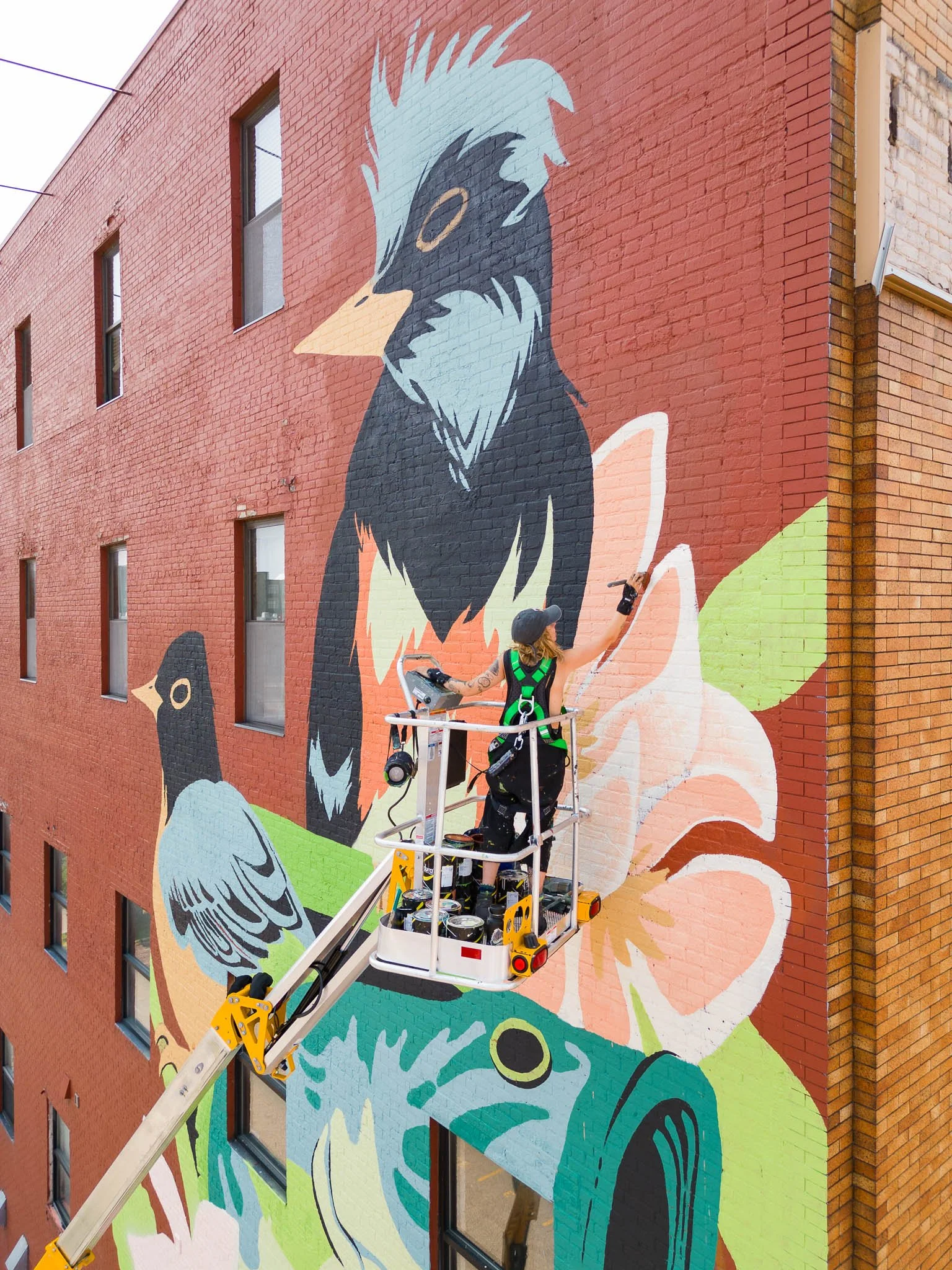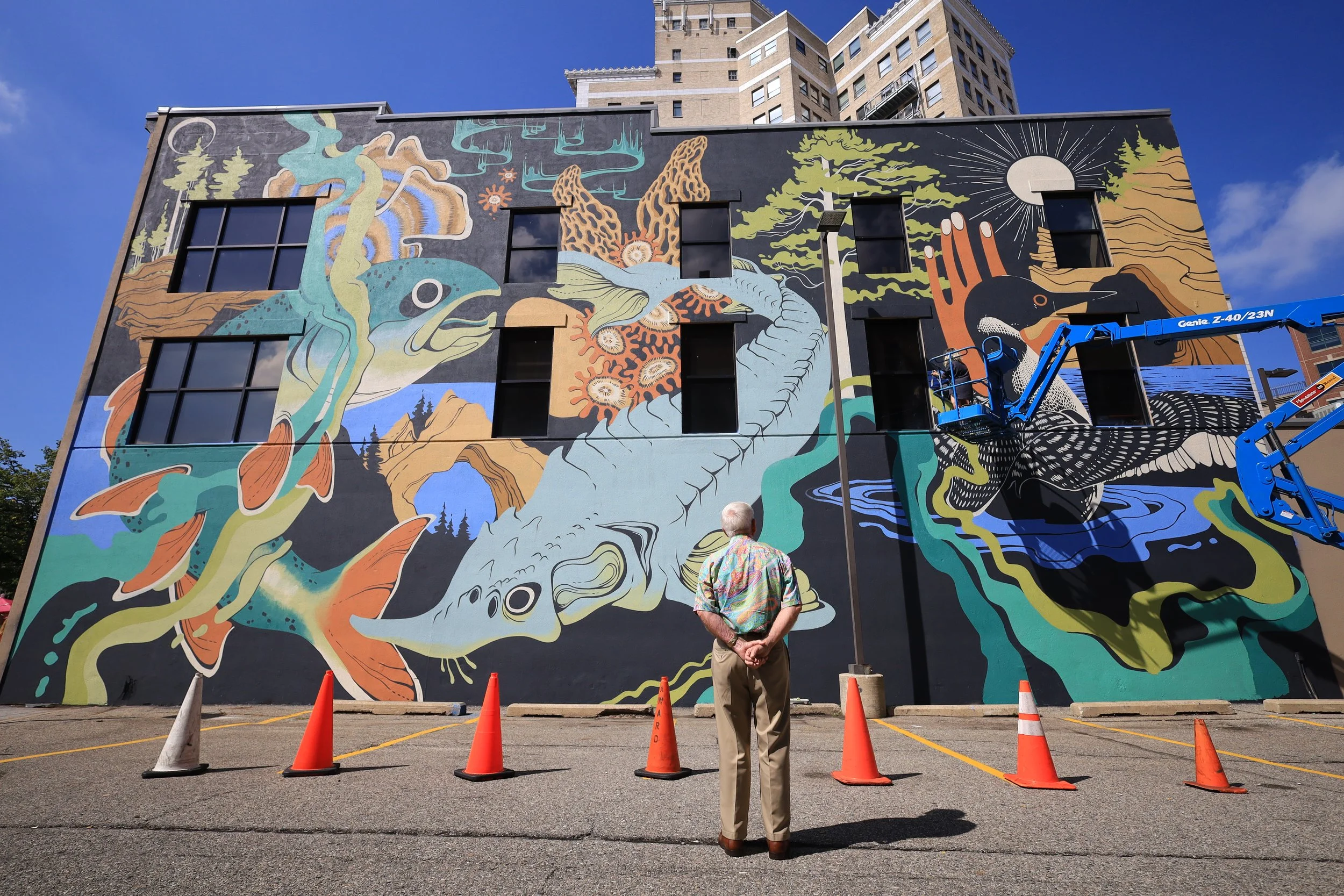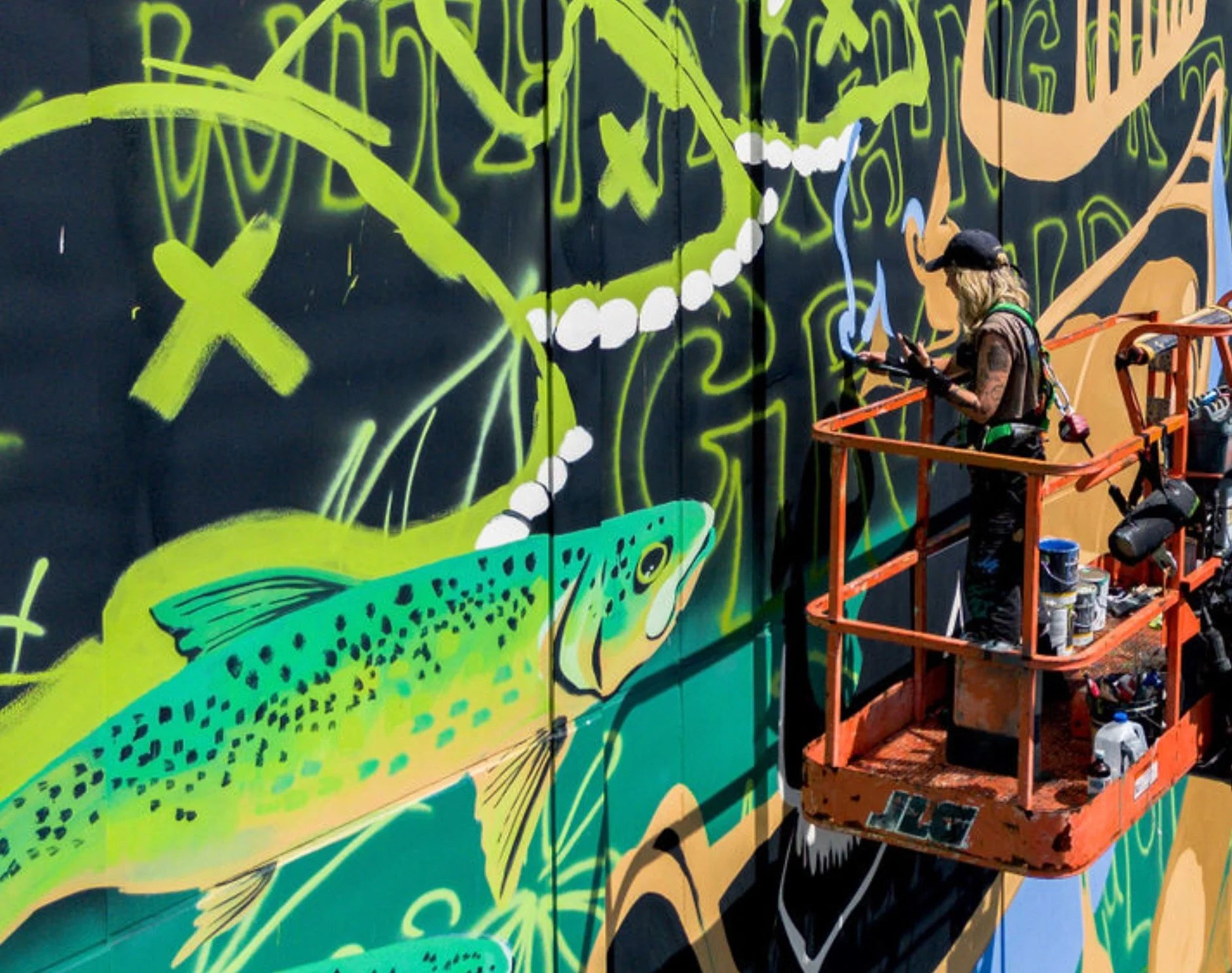
public art!
We believe that public art sparks interest.
From there, education turns interest into knowledge. From knowledge grows appreciation; from appreciation blooms a personal relationship. From such a relationship, a profound commitment to ecological conservation has the space to grow.
Check out our public art initiatives below!
FISH PROJECT!
50 Michigan Artists — Grand Rapids, MI — 2024
These 50 fish species are all native or naturalized to the Grand River. Completed by 50 different Michigan artists for 2024’s Pleasant Peninsula!
2024 Public Art Series
5 Murals — 5 Educators — 5 Artists
These 5 murals are collaborations between local muralists & environmentalists. Each artist was paired with an educator to develop a mural design informed by ecologic research.
-
OAK SAVANNAS: LIMINAL SPACES
Across West Michigan, an observant hiker may spot an old, towering oak with low, sprawling branches among a young forest. These trees are known as “wolf trees” and are an indicator that long ago the tree was not crowded by a forest, but had the space for its branches to grow out, not only up.
With a bit more attention, one may be able to spot other unique species among the wolf trees — prairie grasses and flowers, wild lupine and Karner blue butterflies, eastern box turtles and Cooper’s hawks — all these species are indicators of a remnant oak savanna.
Oak savannas are liminal spaces, the transitional habitat between tallgrass prairies and oak forests. They were once one of the most prevalent ecosystems in the Midwest. Now, less than one percent of the original oak savannas in Michigan remain.
Oak savannas are maintained by periodic fire, which encourages oak regeneration but keeps other species out. Historically, fires would start naturally by lightning, or were set by Native Americans who used fire intentionally as a land management tool. With colonization, fire suppression, and the conversion of land for agriculture, the oak savanna began to vanish.
With the practice of fire suppression, fire-dependent plants and the creatures that rely on them have become increasingly rare. An example of this is the federally endangered Karner blue butterfly. The Karner blue butterfly requires wild lupine for part of their life cycle. Wild lupine is a fire dependent species found in the oak savanna. Without fire and intentional stewardship of these ecosystems, we risk losing these species entirely.
To restore health to an ecosystem that has been in decline for over 150 years will take many decades of careful management and collaboration with organizations, scientists, and land managers. With the support of the community, the Land Conservancy of West Michigan is one of many conservation leaders in the area working to write a new chapter for the oak savanna.
-
ENBRIDGE LINE 5: A THREAT TO MICHIGAN'S NATURAL HERITAGE
In 1953, without public input or tribal consultation, the state of Michigan allowed the oil and gas company Enbridge to build Line 5. This 645-mile pipeline carries over 20 million gallons of crude oil and natural gas liquids across Michigan and through the Straits of Mackinac every day. Now more than 20 years past its anticipated lifespan, the pipeline continues to operate despite Governor Whitmer’s order to shut it down due to concerns over environmental safety.
Enbridge's oil spill record has been marked by several significant incidents. In 2010, a pipeline rupture and an error in reading equipment designed to maintain pipeline safety allowed one million gallons of crude oil to spill into a tributary of the Kalamazoo River. This spill had devastating effects on wildlife and sensitive ecosystems and caused nearly 150 families to evacuate their homes, some of whom were unaware of the pipeline's existence before being forced to relocate due to contamination. Sections of the Kalamazoo River were closed to the public for years, reducing recreational and tribal use of the river. The 2010 Kalamazoo oil spill remains the second-largest inland oil spill in U.S. history.
The Straits of Mackinac have been called the worst place in the Great Lakes for an oil spill to occur. Its continued operation, 200 feet below the surface of Lake Michigan, poses irreparable environmental, economic, and cultural harm. If a spill were to occur there, it would impact a place of great cultural significance to indigenous communities, the drinking water for 40 million people, 700 miles of Great Lakes shoreline, take years to clean up, and contaminate the very natural features that make our state distinguishable from outer space.
Rather than retire the dangerous pipeline, Enbridge has proposed a tunnel project to ensure at least the safety of the Straits; however, the risks the pipeline poses remain as long as Enbridge continues to operate it illegally.
Supporting efforts to halt Line 5 helps protect the Great Lakes, honor tribal rights, and preserve Michigan’s natural heritage. Advocacy, legal support, and raising awareness are key to preventing a catastrophic spill in the heart of our pleasant peninsula.
-
KILL YOUR LAWN FOR POLLINATORS!
Michigan ecosystems face challenges from threats like climate change and development, and lawns aren’t helping! If you condensed all turfgrass in the US into one area, it would be larger than the entire Lower Peninsula! Lawns strain water resources, require fertilizer and upkeep, and provide little habitat or ecosystem services. However, there is an alternative: killing your lawn and replacing it with native plants!
Whether it’s a small strip of wildflowers or a full prairie yard, you can help bring some native ecology back to the city. This not only provides habitat for pollinators and wildlife, but deeply enriches your community: there’s nothing quite like a deep summer evening surrounded by the sights, sounds, and smells of native plants!
Diversity in any pollinator planting is key: variation in plant type, bloom time, and structure will attract diverse wildlife for months. This is beautifully shown in Dania’s linear timeline in the mural: the spring ephemera of red columbine blends into the familiar midsummer pallet of coreopsis and beebalms, with the unique rattlesnake master blooms introducing the rosinweeds with the summer heat. Then purple ironweed of September gives way to the small but mighty asters, who can bloom clear into November!
-
BOGS BOGS BOGS!
What is a bog & why should you care about them?
Bogs are a wetland ecosystem. Bogs within Michigan typically form from glaciation that happened thousands of years ago. They’re made up of peat and sphagnum moss. Sphagnum moss is plant material that is slowly decaying in these unique ecosystems. Plant material within bogs slowly decay due to nutrient poor, high acidic and oxygen poor water. Eventually this sphagnum moss turns into peat which is the bottom layer in bogs. Flora and fauna within these bogs are preserved for longer periods of time within the peat due to these unique conditions.
These diverse ecosystems house extremely diverse flora and fauna including carnivorous plants such as picture plants and sundew plants. The reason that bogs have carnivorous plants in regions that don’t commonly house carnivorous plants is because these plants have evolved to survive in nutrient poor areas where their only source of nutrients are insects.
Why should we care about bogs? Bogs are great for flood control, sphagnum moss acts as a sponge and can retain water during flooding. They’re also known as carbon sinks, meaning they’re able to absorb large quantities of carbon which is extremely important in mitigating the impacts of climate change. Yay bogs!
You can see this diverse wetland ecosystem in action within the greater Grand Rapids area at a place called Saul Lake Bog. Saul Lake Bog is a home to these carnivorous plants, tamarack trees and much more diverse flora and fauna!
-
Vernal Pools
Vernal pools are small, ephemeral wetlands that support incredible biodiversity.
These temporary wetlands serve as breeding and foraging grounds for many sensitive species, including protected species. What may initially seem like a large mud puddle in the forest is actually a miniature ecosystem teeming with life. Vernal pools are often referred to as nature’s nurseries or coral reefs of the northeastern forests. They are home to many amphibians that rely on these wetlands to complete the first part of their life cycle, as well as the freshwater crustacean called fairy shrimp, which exclusively inhabits temporary pools. It's important to celebrate and protect the abundant life found in these pools, with over 550 species documented using vernal pools in the northeastern United States.
Because of their small, isolated, and ephemeral nature, vernal pools often slip through the cracks of our wetlands regulations in Michigan. In order to be protected under current state regulations a wetland must be connected to or within 1,000 feet of the Great Lakes, be connected to or within 500 feet of an inland lake, pond or river/stream, or be over 5 acres in size. Vernal pools also face multiple threats including loss or degradation due to development, roads, timber harvesting, pollution, invasive species, and climate change.
The Chippewa Watershed Conservancy is part of the Michigan Vernal Pools Partnership and is dedicated to the conservation and public education of vernal pools in Michigan. Currently, the CWC has eleven vernal pools mapped that they collect data on. Autumn Baker, Development Coordinator for the CWC monitors these pools and others in central Michigan. She also serves as a Program Coordinator for the Vernal Pool Patrol, a community science-based effort to map and monitor vernal pools in Michigan. In this role, she recruits and supports community scientists and serves as point of contact for private landowners looking to learn about vernal pools. If you are interested in volunteering for this program a three-part virtual training is offered annually in March.
“Look About You!”
Son Visual — Grand Rapids, MI — 2023
This mural, installed along the banks of the Grand River, draws inspiration from Michigan's rich ecological heritage. The central human figure, emerging from the water, symbolizes human interconnectedness with natural freshwater sources. Surrounding the figure are native flora and fauna, including keystone river species like the belted kingfisher and largemouth bass, illustrating biodiversity in the Grand River ecosystem. Also featured are the Michigan state bird (the robin) and the state flower (the apple blossom), celebrating our state's unique ecological landscape.
“Seeking a Pleasant Peninsula!”
Son Visual — Grand Rapids, MI — 2022
By highlighting Michigan’s ecology in the midst of one of our primary urban centers, this mural engages viewers who may not otherwise get the chance to experience Michigan’s natural wonders. The design functions as a spotting guide for some of our native wildlife (brook trout, lake sturgeon, common loon, morels, turkey tail, white pine), while also subtly referencing our ever-changing (and currently receding) shoreline.

